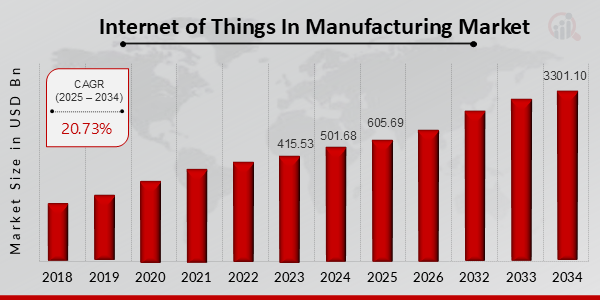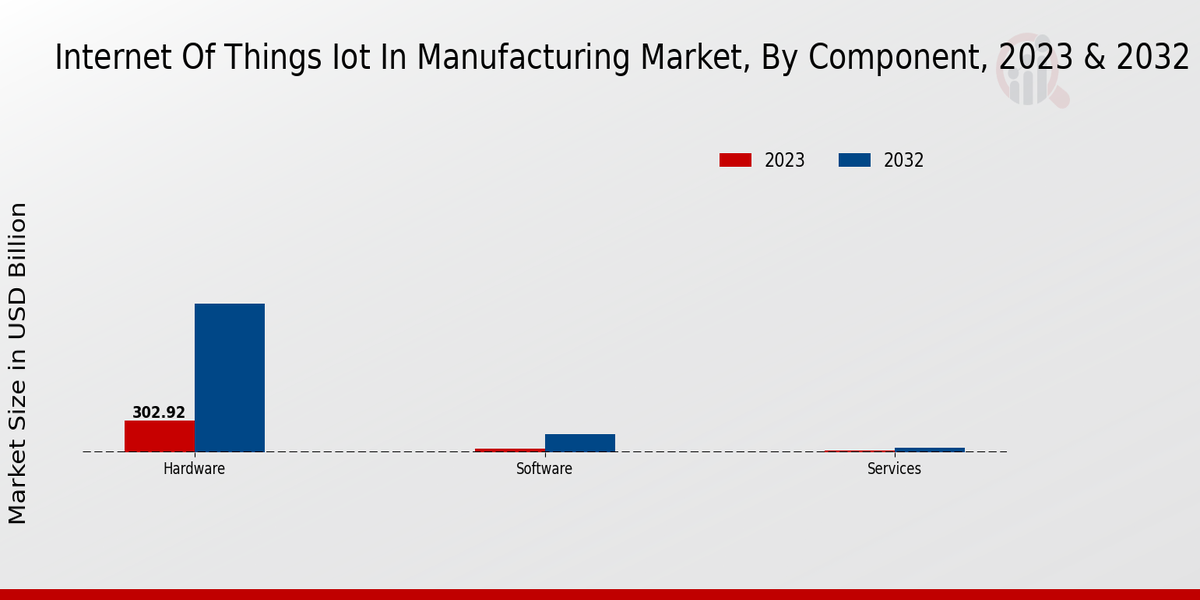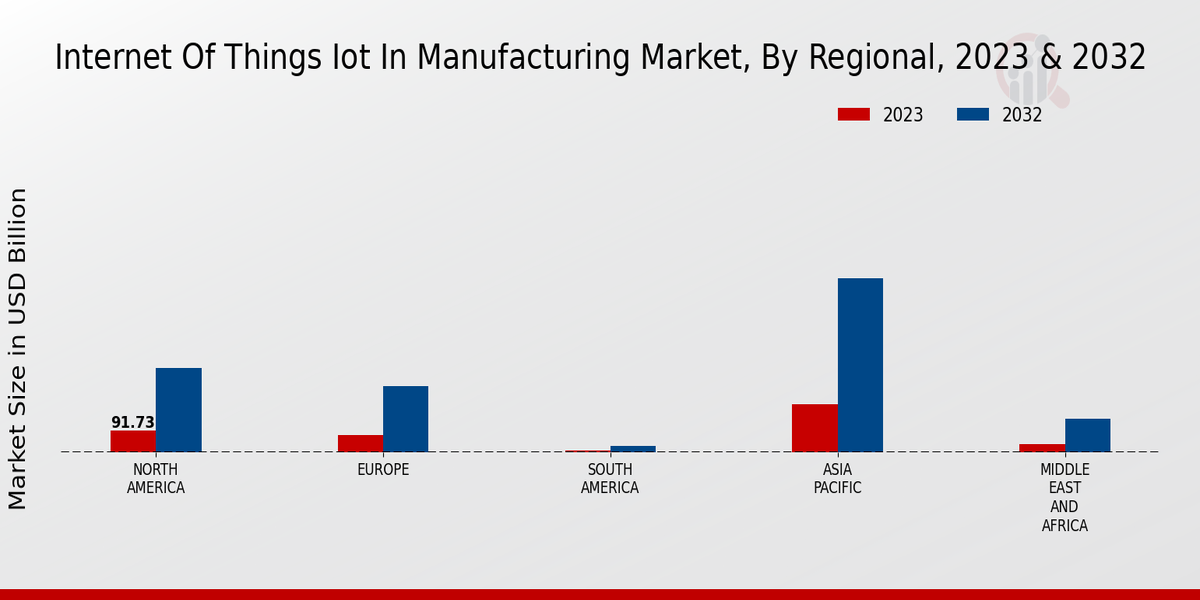Internet of Things (IoT) in Manufacturing Market Overview
Internet of Things (IoT) In Manufacturing Market is projected to grow from USD 605.69 Billion in 2025 to USD 3301.10 Billion by 2034, exhibiting a compound annual growth rate (CAGR) of 20.73% during the forecast period (2025 - 2034).
Additionally, the market size for Internet of Things (IoT) In Manufacturing Market was valued at USD 501.68 billion in 2024.
Key Internet of Things (IoT) in Manufacturing Market Trends Highlighted
The IoT in manufacturing market is undergoing rapid transformation, driven by advancements in wireless connectivity, data analytics, and artificial intelligence. Key market drivers include the need for enhanced productivity, reduced downtime, and improved safety. Organizations are leveraging IoT technologies for predictive maintenance, remote monitoring, and optimized resource utilization.
Opportunities for growth lie in integrating IoT solutions with existing manufacturing processes, enhancing data security, and exploring new applications. Recent trends include the adoption of edge computing, digital twin technologies, and cloud-based IoT platforms. These trends enable real-time decision-making, improve data accessibility, and facilitate collaboration between different stakeholders within the manufacturing environment.
Figure 1: Internet Of Things (IoT) In Manufacturing Market size 2025-2034

Source Primary Research, Secondary Research, MRFR Database and Analyst Review
Internet Of Things (IoT) In Manufacturing Market Drivers
Rising Adoption of Smart Manufacturing Practices
There are several factors currently driving the growth of the internet of things (IoT) in manufacturing market. First, they include the growing adoption of the smart manufacturing approach. It implies the use of IoT devices and sensors for controlling and monitoring manufacturing processes, which can be beneficial for increasing productivity, efficiency, and quality.
As more and more manufacturers adopt a smart manufacturing approach, the demand for IoT devices and solutions is expected to increase dramatically. Second, this trend is also fuelled by government initiatives and policies that encourage using smart manufacturing solutions.
Growing Need for Data Analytics and Process Optimization
The next driver of the growing internet of things (IoT) in manufacturing market is the increasing need for data analytics and process optimization. IoT devices and sensors collect a big amount of data on the manufacturing process, which can be analyzed to understand the areas of improvement.
This data can be used to optimize the process, reduce waste, and enhance efficiency. As manufacturers want to use the data to get more insights and improve their work, the demand for IoT will increase significantly.
Advancements in IoT Technology
The growth of the internet of things (IoT) in manufacturing market is positively influenced by the advancements in Internet of Things technology. The development of new IoT devices and sensors with increased capabilities such as enhanced connectivity, reduced power consumption, and advanced data processing is making IoT solutions more suitable to manufacturers.
In addition, cloud computing and edge computing platforms are surfacing unconventionally to allow manufacturers to store, process, and analyze data from their IoT devices, which is driving the rate of adopting IoT solutions in the manufacturing industry.
Internet Of Things (IoT) in Manufacturing Market Segment Insights
Internet Of Things (IoT) in Manufacturing Market Component Insights
The internet of things (IoT) in manufacturing market is segmented into hardware, software, and services. The hardware segment is expected to hold the largest market share in 2023, owing to the increasing adoption of IoT devices in manufacturing processes.
The software segment is expected to grow at the highest CAGR during the forecast period, due to the growing demand for data analytics and management solutions. The hardware segment includes devices such as sensors, actuators, and controllers that are used to collect and transmit data from manufacturing equipment.
The software segment includes platforms that are used to manage and analyze data from IoT devices, and to provide insights for decision-making. The services segment includes professional services such as consulting, implementation, and support.
The growth of the IoT in manufacturing market is being driven by several factors, including the increasing need for automation and efficiency in manufacturing processes, the growing adoption of cloud computing and big data analytics, and the increasing availability of affordable IoT devices.
Figure 2 : Internet Of Things (IoT) In Manufacturing Market 2023-2032

Source Primary Research, Secondary Research, MRFR Database and Analyst Review
Internet Of Things (IoT) in Manufacturing Market Application Insights
The internet of things (IoT) in manufacturing market is segmented by application into asset tracking, predictive maintenance, quality control, inventory management, process optimization, safety and security.
The asset tracking segment is expected to hold the largest market share in 2023, owing to the increasing demand for real-time tracking of assets in manufacturing facilities. The predictive maintenance segment is expected to grow at the highest CAGR during the forecast period, due to the rising need for predictive maintenance solutions to prevent unplanned downtime and improve operational efficiency.
The quality control segment is also expected to witness significant growth, driven by the need for improved quality control measures in manufacturing processes. The inventory management segment is expected to grow steadily, due to the increasing adoption of IoT-based inventory management solutions to optimize inventory levels and reduce costs.
The process optimization segment is expected to witness moderate growth, as manufacturers seek to optimize their processes and increase productivity. The Safety and Security segment is expected to grow at a steady pace, owing to the increasing need for enhanced safety and security in manufacturing environments.
Internet of Things (IoT) in Manufacturing Market Insights
The internet of things (IoT) in manufacturing market is segmented by industry, with key segments including automotive, aerospace, energy, healthcare, food and beverage, and retail. The automotive segment is expected to hold the largest market share in 2023, driven by the growing adoption of IoT technologies in connected cars and autonomous vehicles.
The aerospace segment is also expected to witness significant growth, as IoT is used to improve aircraft safety and efficiency. The energy segment is another major market for IoT, with applications in smart grids and renewable energy management.
The healthcare segment is also expected to see strong growth, as IoT is used to improve patient care and reduce costs. The food and beverage segment is also expected to witness significant growth, as IoT is used to improve food safety and traceability. The retail segment is also expected to see strong growth, as IoT is used to improve customer experience and optimize supply chains.
Internet of Things (IoT) in Manufacturing Market Deployment Model Insights
The deployment model segment of the internet of things (IoT) in manufacturing market is categorized into on-premise, cloud, and hybrid. On-premise deployment involves installing and managing IoT infrastructure within the manufacturing facility. Cloud deployment involves leveraging cloud computing services to host and manage IoT solutions.
Hybrid deployment combines on-premise and cloud elements to optimize performance and security. In 2023, the cloud deployment model dominated the market, accounting for a revenue share of over 55%. The increasing adoption of cloud-based IoT platforms and services is attributed to the growing demand for remote monitoring, data analytics, and flexible scalability.
The cloud model offers cost-effective solutions, reduces IT infrastructure requirements, and enables real-time data processing. The on-premise deployment model is expected to witness significant growth in the coming years, owing to concerns about data security and privacy. This model provides greater control over data and allows for customization according to specific manufacturing requirements. However, the high upfront investment and maintenance costs associated with on-premise deployment may limit its adoption in certain sectors.
The hybrid deployment model offers a balance between on-premise and cloud deployment, addressing the need for both data security and scalability. By combining the benefits of both models, hybrid deployment provides flexibility, cost optimization, and enhanced security.
Internet Of Things (IoT) In Manufacturing Market Connectivity Insights
The connectivity segment plays a crucial role in the internet of things (IoT) in manufacturing market. It is the foundation for data transmission between devices, machines, and systems, enabling real-time monitoring, control, and automation in manufacturing processes.
In 2023, the IoT in manufacturing market for connectivity was valued at USD 70.5 billion. It is projected to grow exponentially, reaching USD 295.6 billion by 2032, exhibiting a remarkable CAGR of 20.7%. This growth is attributed to the increasing adoption of wireless technologies, such as Wi-Fi, Bluetooth, and Cellular, in manufacturing environments.
Wi-Fi remains the dominant connectivity technology, accounting for a significant share of the market. Its popularity stems from its wide availability, ease of deployment, and ability to provide high-speed data transfer.
Bluetooth is another widely used technology, particularly for short-range communication between devices. Cellular connectivity offers reliable and secure data transmission over long distances, making it suitable for remote monitoring and control applications. RFID (Radio Frequency Identification) and LoRa (long range) are gaining traction in specific manufacturing applications.
RFID tags are used for asset tracking and inventory management, while LoRa is suitable for low-power, long-range communication in harsh industrial environments. The market growth is driven by factors such as the increasing need for operational efficiency, predictive maintenance, and remote asset management in manufacturing industries. The adoption of IoT solutions enables manufacturers to improve productivity, reduce costs, and enhance product quality.
Internet Of Things (IoT) In Manufacturing Market Regional Insights
The internet of things (IoT) in manufacturing market is segmented into North America, Europe, APAC, South America, and MEA. The market valuation in North America was around 91.73 billion USD in 2023 and is expected to grow to 358.41 billion USD by 2032, exhibiting a CAGR of 17.87% during the forecast period. Europe held the second-largest revenue share in the market, with a valuation of approximately 70.75 billion USD in 2023. This regional market is anticipated to expand at a CAGR of 19.14% and reach a valuation of 279.97 billion USD by 2032.
The APAC region is projected to register the highest CAGR of 22.57% during the forecast period, owing to the increasing adoption of IoT in manufacturing industries in countries such as China, Japan, and India. The market in South America is anticipated to grow at a CAGR of 18.35%, while the MEA region is expected to exhibit a CAGR of 20.24% during the forecast period.
Figure 3 : Internet Of Things (IoT) In Manufacturing Market 2023-2032

Source Primary Research, Secondary Research, MRFR Database and Analyst Review
Internet Of Things (IoT) In Manufacturing Market Key Players and Competitive Insights
The internet of things (IoT) in manufacturing market is a highly competitive industry with a wide range of major players. Leading players are making continuous efforts to explore new solutions and technologies to stay ahead of the market. The market’s competitive landscape includes rivalry among major market players, emergence of new entrants, strategic partnerships, and collaborations. Major players are continuously investing in research to introduce new and innovative services.
One significant player in the IoT in manufacturing market is General Electric Corporation. The company offers a variety of IoT solutions for the manufacturing industry, including predictive maintenance, asset tracking and remote monitoring.
Furthermore, General Electric is a worldwide company that serves a broad range of customers across different sectors. The company’s dedication to innovation and keeping customer relationships at the highest priority has provided an opportunity for GE to remain at the top of the market.
Another significant market player is Siemens. The company offers end-to-end IoT solutions, such as digital twin technology, smart factory and cloud-based analytics. Siemens is actively promoting the development and adoption of Industry 4.0 solutions.
Key Companies in the Internet of Things (IoT) in Manufacturing Market Include
- Schneider Electric
- General Electric
- Siemens
- Dell Technologies
- ABB
- Honeywell
- Oracle
- PTC
- Hitachi
- IBM
- SAP
- Emerson Electric
- Cisco Systems
- Rockwell Automation
- Mitsubishi Electric
Internet Of Things (IoT) In Manufacturing Market Developments
The internet of things (IoT) in manufacturing market is projected to reach $1875.0 billion by 2032, exhibiting a CAGR of 20.73% from 2024 to 2032. This growth is attributed to the increasing adoption of IoT solutions to enhance operational efficiency, optimize supply chains, and improve product quality.
Key players in the market include Siemens, General Electric, Rockwell Automation, and Honeywell. Recent developments include the launch of new IoT platforms, such as Microsoft Azure IoT and Amazon Web Services IoT Core, which provide manufacturers with access to cloud-based infrastructure and analytics tools. Additionally, the integration of artificial intelligence (AI) and machine learning (ML) into IoT solutions is expected to drive market growth by enabling predictive maintenance and automated decision-making.
Internet of Things (IoT) in Manufacturing Market Segmentation Insights
Internet of Things (IoT) in Manufacturing Market Component Outlook
- Hardware
- Software
- Services
Internet of Things (IoT) in Manufacturing Market Application Outlook
- Asset Tracking
- Predictive Maintenance
- Quality Control
- Inventory Management
- Process Optimization
- Safety and Security
Internet of Things (IoT) in Manufacturing Market Outlook
- Automotive
- Aerospace
- Energy
- Healthcare
- Food and Beverage
- Retail
Internet of Things (IoT) in Manufacturing Market Deployment Model Outlook
Internet of Things (IoT) in Manufacturing Market Connectivity Outlook
- Wi-Fi
- Bluetooth
- Cellular
- RFID
- LoRa
Internet of Things (IoT) in Manufacturing Market Regional Outlook
- North America
- Europe
- South America
- Asia Pacific
- Middle East and Africa
Internet Of Things (IoT) In Manufacturing Market Report Scope
|
Report Attribute/Metric
|
Details
|
|
Market Size 2024
|
501.68 (USD Billion)
|
|
Market Size 2025
|
605.69 (USD Billion)
|
|
Market Size 2034
|
3301.10 (USD Billion)
|
|
Compound Annual Growth Rate (CAGR)
|
20.73% (2025 - 2034)
|
|
Report Coverage
|
Revenue Forecast, Competitive Landscape, Growth Factors, and Trends
|
|
Base Year
|
2024
|
|
Market Forecast Period
|
2025 - 2034
|
|
Historical Data
|
2019 - 2023
|
|
Market Forecast Units
|
USD Billion
|
| Key Companies Profiled |
Schneider Electric, General Electric, Siemens, Dell Technologies, ABB, Honeywell, Oracle, PTC, Hitachi, IBM, SAP, Emerson Electric, Cisco Systems, Rockwell Automation, Mitsubishi Electric |
| Segments Covered |
Component, Application, Industry, Deployment Model, Connectivity, Region |
| Key Market Opportunities |
1. Predictive Maintenance 2. Real-time Asset Tracking 3. Remote Monitoring 4. Personalized Product Manufacturing 5. Enhanced Supply Chain Management |
| Key Market Dynamics |
1. Increasing Adoption 2. Technological Advancements 3. Growing Demand 4. Government Initiatives 5. Data Security Concerns |
| Countries Covered |
North America, Europe, APAC, South America, MEA |
Frequently Asked Questions (FAQ) :
The IoT in manufacturing market was valued at USD 344.17 billion in 2023 and is projected to reach USD
3301.10 billion by 2034, exhibiting a CAGR of 20.73%.
North America and Europe are the dominant regions, accounting for a significant share of the market revenue.
IoT in manufacturing finds applications in various areas, including predictive maintenance, remote monitoring, inventory management, quality control, and process optimization.
Prominent players include Siemens, General Electric, Rockwell Automation, Schneider Electric, ABB, Honeywell, Cisco, IBM, and PTC.
Growth is driven by factors such as increasing demand for automation, growing adoption of cloud computing, and government initiatives to promote digital transformation in manufacturing.
Challenges faced by the market include concerns related to data security, lack of interoperability standards, and skilled workforce shortage.
Emerging trends include the adoption of artificial intelligence (AI), blockchain technology, and digital twin technology.
IoT can significantly improve manufacturing productivity by enabling real-time monitoring, predictive maintenance, and automated processes, leading to reduced downtime and increased efficiency.
IoT is transforming the supply chain in manufacturing by enhancing visibility, optimizing inventory levels, and enabling predictive analytics, resulting in improved efficiency and reduced costs.
IoT offers numerous benefits to manufacturers, including improved operational efficiency, reduced costs, enhanced product quality, and increased customer satisfaction.

















